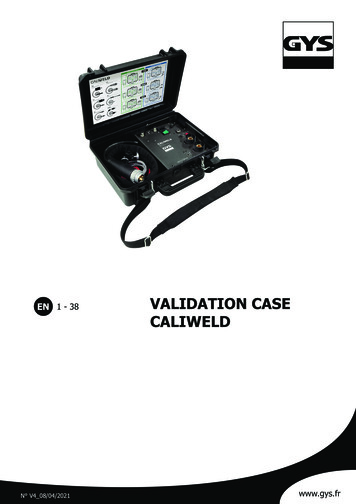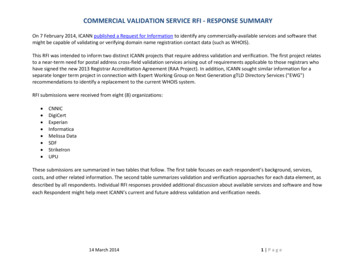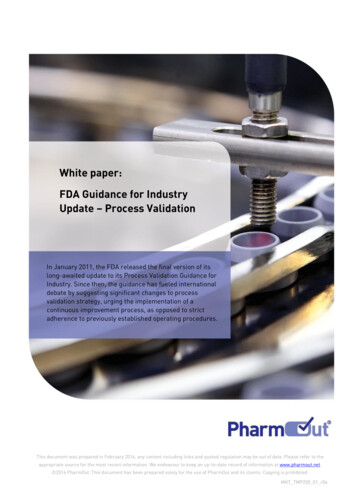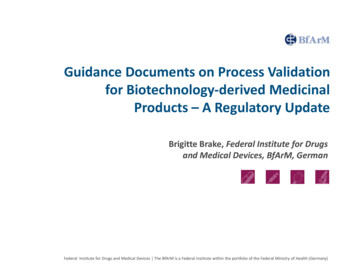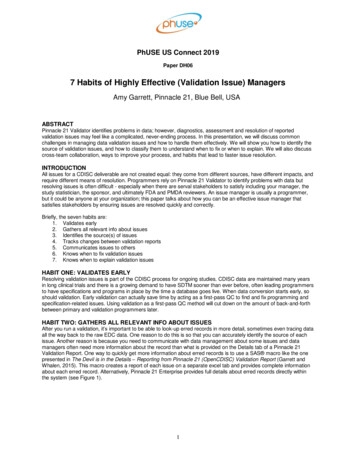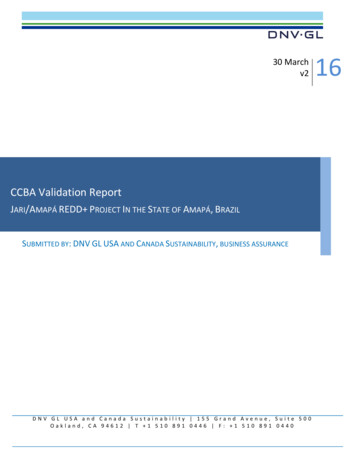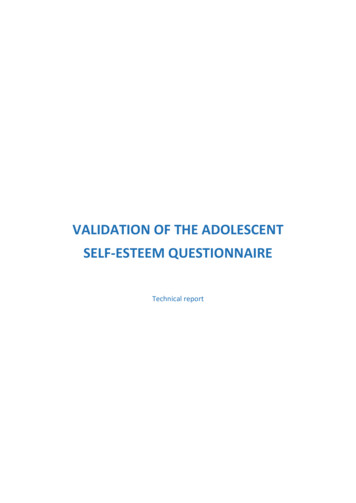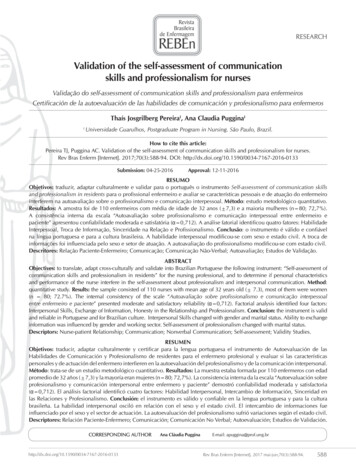
Transcription
RESEARCHValidation of the self-assessment of communicationskills and professionalism for nursesValidação do self-assessment of communication skills and professionalism para enfermeirosCertificación de la autoevaluación de las habilidades de comunicación y profesionalismo para enfermerosThaís Josgrilberg PereiraI, Ana Claudia PugginaIIUniversidade Guarulhos, Postgraduate Program in Nursing. São Paulo, Brazil.How to cite this article:Pereira TJ, Puggina AC. Validation of the self-assessment of communication skills and professionalism for nurses.Rev Bras Enferm [Internet]. 2017;70(3):588-94. DOI: ssion: 04-25-2016Approval: 12-11-2016RESUMOObjetivos: traduzir, adaptar culturalmente e validar para o português o instrumento Self-assessment of communication skillsand professionalism in residents para o profissional enfermeiro e avaliar se características pessoais e de atuação do enfermeirointerferem na autoavaliação sobre o profissionalismo e comunicação interpessoal. Método: estudo metodológico quantitativo.Resultados: A amostra foi de 110 enfermeiros com média de idade de 32 anos ( 7,3) e a maioria mulheres (n 80; 72,7%).A consistência interna da escala “Autoavaliação sobre profissionalismo e comunicação interpessoal entre enfermeiro epaciente” apresentou confiabilidade moderada e satisfatória (α 0,712). A análise fatorial identificou quatro fatores: HabilidadeInterpessoal, Troca de Informação, Sinceridade na Relação e Profissionalismo. Conclusão: o instrumento é válido e confiávelna língua portuguesa e para a cultura brasileira. A habilidade interpessoal modificou-se com sexo e estado civil. A troca deinformações foi influenciada pelo sexo e setor de atuação. A autoavaliação do profissionalismo modificou-se com estado civil.Descritores: Relação Paciente-Enfermeiro; Comunicação; Comunicação Não-Verbal; Autoavaliação; Estudos de Validação.ABSTRACTObjectives: to translate, adapt cross-culturally and validate into Brazilian Portuguese the following instrument: “Self-assessment ofcommunication skills and professionalism in residents” for the nursing professional, and to determine if personal characteristicsand performance of the nurse interfere in the self-assessment about professionalism and interpersonal communication. Method:quantitative study. Results: the sample consisted of 110 nurses with mean age of 32 years old ( 7.3), most of them were women(n 80; 72.7%). The internal consistency of the scale “Autoavaliação sobre profissionalismo e comunicação interpessoalentre enfermeiro e paciente” presented moderate and satisfactory reliability (α 0,712). Factorial analysis identified four factors:Interpersonal Skills, Exchange of Information, Honesty in the Relationship and Professionalism. Conclusion: the instrument is validand reliable in Portuguese and for Brazilian culture. Interpersonal Skills changed with gender and marital status. Ability to exchangeinformation was influenced by gender and working sector. Self-assessment of professionalism changed with marital status.Descriptors: Nurse-patient Relationship; Communication; Nonverbal Communication; Self-assessment; Validity Studies.RESUMENObjetivos: traducir, adaptar culturalmente y certificar para la lengua portuguesa el instrumento de Autoevaluación de lasHabilidades de Comunicación y Profesionalismo de residentes para el enfermero profesional y evaluar si las característicaspersonales y de actuación del enfermero interfieren en la autoevaluación del profesionalismo y de la comunicación interpersonal.Método: trata-se de un estudio metodológico cuantitativo. Resultados: La muestra estaba formada por 110 enfermeros con edadpromedio de 32 años ( 7,3) y la mayoría eran mujeres (n 80; 72,7%). La consistencia interna da la escala “Autoevaluación sobreprofesionalismo y comunicación interpersonal entre enfermero y paciente” demostró confiabilidad moderada y satisfactoria(α 0,712). El análisis factorial identificó cuatro factores: Habilidad Interpersonal, Intercambio de Información, Sinceridad enlas Relaciones y Profesionalismo. Conclusión: el instrumento es válido y confiable en la lengua portuguesa y para la culturabrasileña. La habilidad interpersonal osciló en relación con el sexo y el estado civil. El intercambio de informaciones fueinfluenciado por el sexo y el sector de actuación. La autoevaluación del profesionalismo sufrió variaciones según el estado civil.Descriptores: Relación Paciente-Enfermero; Comunicación; Comunicación No Verbal; Autoevaluación; Estudios de Validación.CORRESPONDING 3Ana Cláudia PugginaE-mail: apuggina@prof.ung.brRev Bras Enferm [Internet]. 2017 mai-jun;70(3):588-94.588
Pereira TJ, Puggina AC.Validation of the self-assessment of communication skills and professionalism for nursesINTRODUCTIONCommunication is a form of interaction in which individualsshare opinions, ideas, information, messages and feelings, andit may influence people’s behavior, causing reactions related tobeliefs, culture, reality and life history of those involved(1).Interpersonal relationship between professionals and patients uses communication as a basic element, in order to allow the patients to understand their problems and treatmentplan(1). The professional that demonstrates communicationskills may handle the situations of dealing with patients moreeffectively. Communication is an essential skill in the professional training of healthcare professionals(2).Instruments that assess communication can be of great value for individual interventions, improving relationships andcare. However, evaluating interpersonal communication morethoroughly may demand more than one technique or the useof different instruments, such as observation of interactions,group dynamics, recording and interpreting non-verbal communication, among others(3).Considering the importance of communication in the doctor-patient relationship, the American Board of Internal Medicine (ABIM) uses an instrument in which the patient evaluatesthe physician, part of an analysis of continuing professionaldevelopment of the medical professional, to address communication skills.Based on the instrument used by ABIM, the “Self-assessment of communication skills and professionalism in residents” is a scale composed of 11 items, measured by a 3-pointLikert scale, divided into two subscales: Interpersonal Relations and Conveying Medical Information. The validity studyof this questionnaire indicated an internal consistency reliability of 0.82 for the Interpersonal Relations subscale and of 0.80for the Conveying Medical Information subscale(4).The objectives of this study were to translate, adapt cross-culturally and validate into Portuguese the instrument “Self-assessment of communication skills and professionalism in residents”,the first modified version of the ABIM instrument, elaborated bySymons, Swanson, McGuigan, Orrange e Akl(2009)(4). It was initially proposed for medical residents and nursing professionals,in order to evaluate if personal characteristics and performanceof the professional interfere in the self-assessment about professionalism and interpersonal communication.METHODEthical aspectsAuthorization from the researcher Andrew Symons was requested to translate, adapt and validate the instrument. Thedevelopment of the study met the national and internationalstandards of research ethics involving human beings, based onResolution 466/12.Design, study location and periodThis is a quantitative study carried out in two phases: content validation, which includes translation and cross-culturaladaptation, and construct validation.The study was conducted in five hospitals and two higher education institutions in the city of Dourados, in the State of MatoGrosso do Sul. Data collection occurred from February to September 2014.Sample size; inclusion and exclusion criteriaThe convenience sample consisted of 11 Nursing professorsfor the pre-test phase. For the pre-final phase, the calculationof the minimum value for validation of the instrument was obtained through the recommended criterion of 10 participantsper item of the original scale, adding up to 110 participants(5).As inclusion criterion, the participants should be nursing assistants or Nursing professors who guide internships within hospital units. Nurses on vacation, maternity leave, medical leaveor that only acted in administrative functions were excluded.Study protocolThe internationally recommended steps for the process ofcross-cultural adaptation and validation were followed in order to evaluate linguistic and cultural equivalence betweenthe original and translated versions: translation, synthesis,back translation, expert committee review, pretesting, andpre-final testing(5).In the first stage, translations T1 and T2 were performedby two independent bilingual translators, one who knew thetheme of the scale and one who did not. In a second stage, athird bilingual professional, with knowledge of the Brazilianculture and language and of the English language proposed asynthesis of the two translations (T12).After the synthesis of the translations, in a third step, twoNative American translators developed the back translation(R1 and R2), only accessing the synthesis of the translations.In the fourth stage, a committee of judges with 10 professionals was appointed, having among them: bilinguals; methodologists; health professionals; linguists and translators. Inpossession of the T1, T2, T12, R1 and R2 versions and thescale application guidelines, the committee compared theversions, evaluating the semantic and idiomatic equivalence,and then a pre-test version proposal was elaborated (Figure 1).Semantic equivalence is understood as the evaluation ofcorrespondence of grammar and vocabulary between the versions, since there are words from one language that do nothave an adequate translation for another. Idiomatic equivalence addresses the difficulties in translating colloquial expressions of a given language(6).In the fifth and last step of the content validation process,11 teaching nurses evaluated the pre-test version qualitatively,answering the scale items and then answering two essay questions in order to verify if there was any doubt or difficultyunderstanding the items.From the suggestions obtained in the pre-test, the pre-final version of the scale “Autoavaliação sobre profissionalismo e comunicação interpessoal entre enfermeiros e pacientes” was elaboratedand then submitted to evaluation of the psychometric properties.In the content validity study of the original instrument, the11 items were initially measured by a five-point Likert scale,but with the statistical tests, the American authors4 chose toRev Bras Enferm [Internet]. 2017 mai-jun;70(3):588-94.589
Pereira TJ, Puggina AC.Validation of the self-assessment of communication skills and professionalism for nurses(n 50; 45.5%). Regarding professional training time, themean was 6 years ( 4,8), and most of the participants werespecialists (n 69; 62.7%). The most frequent working sectorwas the medical ward (n 48;43.6%) followed by intensivecare units (n 29; 26.4%).TRANLATIONSIn this study, the coefficientParticipation of 5 translatorsORIGINAL SCALEof internal consistency of thescale “Autoavaliação sobre proCOMMITTEE OF JUDGESParticipation of 10 professionalsfissionalismo e comunicaçãointerpessoal entre enfermeirosTRANSLATION 1TRANSLATION 2Brazilian and SpecialistBrazilian andPRE-TEST VERSIONe pacientes” presented moderin communicationLinguistate reliability of 0.712. ModPRE-TESTE VERSION EVALUATIONerate reliability is when theParticipation of 11 nursesSYNTHESIS OF THECronbach’s Alpha is betweenTRANSLATIONS0.65 and 0.75, however, anBrazilian andalpha over 0.70 is consideredJournalistsatisfactory(4).The factorial analysis identifiedPRE-FINAL VERSIONfourfactors: Interpersonal SkillsBACK TRANSLATION 1BACK TRANSLATION 2AmericanAmerican(items2, 3, 4 and 5), ExchangePRE-FINAL VERSION EVALUATIONParticipation of 110 nursesof Information (items 6, 7 and8), Honesty in the RelationshipPRE-TEST VERSIONFINALVERSION(items 1 and 9) and ProfessionalVersion analyzed by thecommittee of judgesism (Items 10 and 11). (Table 1)The Cronbach’s alpha was calculated for each item. The lowestresult was in item 5, with a valueFigure 1 – Steps of the validation process, characteristics of the translators and numberof 0.662, and the highest resultsof participants in each stage, Dourados, Mato Grosso do Sul, Brazil, 2014were in items 1 and 10, whichobtained the same Alpha ofA three-point Likert scale is less reliable and cannot accurately0.715, showing that all items are within a moderate and satisfacdemonstrate the interviewee opinion; a five-point scale, is genertory Cronbach’s alpha. Correlations between items and total wereally more accurate, easier and faster than a seven-point scale(7).positive, indicating consistency between items and total. (Table 2)Construct validationContent validationgroup the answers in a three-point Likert scale for a betterpresentation of the results. In the current study, the five-pointLikert scale was maintained.Result analysis and statisticsConstruct validation was conducted through statistical analysisof the data from the pre-final test, using factorial analysis. The reliability of the instrument was verified through Cronbach’s Alpha.The factors were established through factorial analysis, having ascriterion of number of domains the value 1, and as criterion forthe input of variables in the domain the 0.5 flag.The factors of the scale “Autoavaliação sobre profissionalismo e comunicação interpessoal entre enfermeiros e pacientes” were studied regarding the distribution of data through theKolmogorov-Smirnov test. Since they did not show adherenceto the normal distribution curve, they were studied accordingto the characteristics of the sample using Mann-Whitney nonparametric tests (when the variable addressed was divided intwo categories) or Kruskal-Wallis (when the variable addressedwas divided in 3 or more categories). The significance level wasset at 5%. The software used for analysis was SAS version 9.5.RESULTSThe sample consisted of 110 nurses, with a mean age of 32years ( 7.3), mostly women (n 80; 72.7%) and mostly singleTable 1 –Factors obtained through Rotation of Factors,Dourados, Mato Grosso do Sul, Brazil, 2014Factor 1Factor 2Factor 3Factor 4Interpersonal Exchange of Honesty in theProfessionalismSkillsInformation *-8106211-70*111221383*Note: *Values are multiplied by 100 and rounded; Higher values are groupedinto factors.Rev Bras Enferm [Internet]. 2017 mai-jun;70(3):588-94.590
Pereira TJ, Puggina AC.Table 2 –Validation of the self-assessment of communication skills and professionalism for nursesCronbach’s alpha and correlation with the total by item of the scale “Autoavaliação sobre profissionalismo e comunicação interpessoal entre enfermeiro e paciente”, Dourados, Mato Grosso do Sul, Brazil, 2014Correlation Cronbach’swith totalalphaItemsnn1Telling them everything; being truthful, upfront and frank; not keeping things from them that they should know.0.2020.7152Greeting them warmly; calling them by the name they prefer; being friendly, never crabby or rude.0.4060.6853Treating them like they're on the same level; never "talking down" to them or treating them like a child.0.4590.6764Letting them tell their story; listening carefully; asking thoughtful questions; not interrupting them whilethey're talking.0.4470.6785Showing interest in them as a person; not acting bored or ignoring what they have to say.0.5520.6626Warning them during the physical exam about what you are going to do and why; telling them what you find.0.2300.7117Discussing options with them; asking their opinion; offering choices and letting them help decide what todo; asking what they think before telling them what to do.0.3020.7008Encouraging them to ask questions; answering them clearly; never avoiding their questions or lecturing them.0.4770.6739Explaining what they need to know about their problems, how and why they occurred, and what to expect next.0.3950.686Using words they can understand when explaining their problems and treatment; explaining any technical10medical terms in plain language.0.2050.71511 How would you rate your level of professionalism?0.2740.705Interpersonal Skills0.3760.402Exchange of Information0.3360.439Honesty in the torsInternal consistency of the instrumentTable 3 – Total score and stratified by factor of the scale “Autoavaliaçãowas assessed through Cronbach’s Alpha.sobre profissionalismo e comunicação interpessoal entre enferThe results were conclusive to confirmmeiro e paciente”, Dourados, Mato Grosso do Sul, Brazil, 2014homogeneity in the items and there was aNumberScoreStandardpositive correlation between them, meanMeanMedianFactorsof items variationDeviationing that when one increases the othernnnnalso tends to increase, indicating consisInterpersonal Skills44-2018.22.019.0tency between the factors and the total.Regarding the factors identified and theExchange of Information33-1512.41.913.0alpha value, the alpha was relatively low.Honesty in the Relationship22-108.31.28.0However, they presented positive correlaProfessionalism22-108.90.89.0tion, therefore they should not be used asTotal1111-5547.83.9948subscale and there was no suggestion toeliminate an item. (Table 2)The scale “Autoavaliação sobre profissionalismo e comucomunicação interpessoal entre enfermeiro e paciente” therenicação interpessoal entre enfermeiros e paciente” has 11was a majority of “always” answers in the items 2 (n 71;items, measured through a five-point Likert scale in items 1 to64.5%), 3 (n 89; 80.9%), 5 (n 76; 69.1%), 6 (n 63; 57.3%)10 (1- never, 2- rarely, 3- sometimes, 4- often, 5- always) ande 10 (n 84; 76.4%). These answers show that the nurses inanother Likert scale in item 11 (1- low, 2- low to moderate,terviewed greet patients, call them by their names, are friendly,3- moderate, 4- moderate to high, 5- high). Higher scores inditreat them as equals, show interest in them as people, warncate a better self-assessment on professionalism and nurse-pathem during the physical exam about what they are going to dotient communication. The mean total score of the participants’and why, use understandable words and explain the technicalanswers was 47.8 ( 3.99). (Table 3).terms used. There was also a majority of the answer “moderateRegarding the descriptive analysis of the participant’s anto high” in the item 11 (n 68; 61.8%), in which nurses classifyswers in the scale “Autoavaliação sobre profissionalismo etheir level of professionalism.Rev Bras Enferm [Internet]. 2017 mai-jun;70(3):588-94.591
Pereira TJ, Puggina AC.Validation of the self-assessment of communication skills and professionalism for nursesComparing the characteristics of the sample with thefactors of the scale, a statistically significant difference wasfound in the factor Interpersonal Skills associated with Gender (p-value 0.047). This result shows that women self-report themselves as having better Interpersonal Skills. Another statistically significant association, still related to Gender(p-value 0.037) was identified in the factor Exchange ofInformation, in which women also presented better selfassessment. (Table 4)Table 4 –Analysis of the scale factors “Autoavaliação sobreprofissionalismo e comunicação interpessoal entreenfermeiro e paciente” according to characteristicsof the sample, Dourados, Mato Grosso do Sul, Brazil, 2014MeanStandarddeviationMedianpvalueInterpersonal rital 19.018.019.019.0n0.0470.020Information 37Working sectorICUSurgery CenterEmergency ionalismMarital g9.30.89.5Note: Kruskal-Wallis Test / *Mann-Whitney Test; 1Others: Hospital Infection Commission and Bandaging Commission; ICU – Intensive Care Unit.Statistical relevance was found in the characteristic MaritalStatus in relation to the factor Interpersonal Skills (p-value 0.020), in which single professionals presented a lower performance when compared to married, widowed, separated,divorced or cohabiting professionals. (Table 4)Association between the variable Working sector and thefactor Information Exchange (p-value 0.036) showed statistical significance. The sector identified as “others”, which includes the Hospital Infection Commission and the BandagingCommission, had a mean of 9.3 and stood out as the sectorthat least performs exchange of information. (Table 4)The variable Marital Status related to the factor Professionalism(p-value 0,036) presented statistical relevance. Married and cohabiting individuals assessed themselves with better professionalism and more adequate use of language with the patient (Table 4).DISCUSSIONThe choice for an instrument created in another culture andanother language gives the researchers, and the others involved,a challenge to make it suitable for a new reality, which is facedthrough a systematic method of translation and cross-cultural adaptation. Cross-cultural adaptation involves a process that analyzes language through translation and studies issues related tothe cultural adaptation, within the stages to adapt an instrumentto a new reality. As this is a prerequisite for studies carried outusing the same instrument in different cultures(8).This study is the first to test the psychometric propertiesthrough the validity and reliability tests of this instrument forthe Brazilian reality. Research instruments that allow comparisons between different realities broaden the discussion aboutthe subject of interest.The communication process is complex and involves intrinsic and extrinsic factors. Interpersonal relationships occurthrough verbal and non-verbal messages, and the non-verbaldimension is more expressive than the verbal one(1), sincepeople do not say all they think or feel. However, verbal communication tends to be less subjective than manifestations involving gesture, facial and body expressions and tone of voice.The fact that the proposed instrument is a self-assessment instrument, which depends on the reflexive and critical capacitiesof the professionals concerning their own performance, can bea limitation of the instrument. However, because it is predominantly based on the self-assessment of verbal communication, theindividual can answer the items more easily. This instrument maybe useful for quick diagnoses as well as for the education and improvement of nurse-patient interpersonal communication.The first factor, Interpersonal Skills, addresses the ability ofthe individual to react to the presence of the other and emphasizes non-verbal communication, including the gesturesused, the treatment dispensed to the other person, listening,demonstrating interest for the other. If this ability is evaluatedwith a high value, it means that the individual self-assessesherself/himself as capable of effectively interacting.In this study, competence and ability are regarded as synonyms, as in another study(3). Interpersonal ability or interpersonal competence is the ability to deal effectively withRev Bras Enferm [Internet]. 2017 mai-jun;70(3):588-94.592
Pereira TJ, Puggina AC.Validation of the self-assessment of communication skills and professionalism for nursesinterpersonal relationships, interacting with others accordingto the particular situations and to the needs of the other(9).The factor Exchange of Information shows the professional’s ability to send and receive relevant information. If the professionals’ self-assessment in the three items included in thisfactor is high, it shows that, according to their opinion, theysend and receive clear, objective and adequate informationand maintain a coherent communication process.This factor is based on verbal communication, which mustbe bidirectional and have the messages validated in order to beconsidered effective(1). An adequate and effective communication contributes to the quality of the nurses’ care, especially inunknown procedures, which bring fear and anxiety to the patient.The third factor is Honesty in the Relationship. The items inthis factor demonstrate the need to tell the patient everythingthat is pertinent during health monitoring. The nurse that selfassessed himself/herself with high values in the items 1 and 9confirmed they were honest in this relationship, indicating theveracity of the information, given with no distortion.A qualitative study addressing comprehensive care, with adiverse population including teachers, students, health servicesmanagers and nurses concluded, based on their speeches, thatthe care must be based on a committed, responsible, sincere andtrustworthy relationship between users and professionals(10). Honesty, as it can be observed, is also regarded in other realities, suchas comprehensive care, emphasizing professional relationships.The last factor, Professionalism, is composed by two itemsin which the nurses evaluate their professionalism accordingto their own perspective. Professionalism involves intense andcontinuous acquisition of knowledge, standards and behaviors that are essential to a proper exercise of the professionalactivity(11). In the context of the scale, the factor Professionalism is understood as directly related to communication skills.Considering the associations made in the present study, interpersonal skills and ability to exchange information dependon gender. Other studies(12-13) found in the literature also indicate a possible association between interpersonal communication and gender.A European study explored gender differences in emerging language skills in 13,783 European children from 10non-English language communities. For this, the authors usedan adapted version of the MacArthur-Bates CommunicativeDevelopment Inventories. The results showed that girls areslightly ahead of boys in early communicative gestures, in productive vocabulary, and in combining words. The differenceincreased with age. Despite the large variation in languageskills between communities, the difference between girls andboys remained. This suggests that the difference is caused byintrinsic factors that do not change between communities(12).Another study concluded that the ability to perceive andunderstand others’ intentions and actions depends on gender. For this, the authors administered a visual task to femaleand male participants of two groups, adolescents between 13and 16 years old and young adults. The main outcome of thestudy showed no difference in the performance of the taskby female and male participants in both groups; however, thefindings were discussed in terms of gender-related behavioralcomponents and brain mechanisms involved in visual socialperception(13).The association between a higher self-assessment of professional/interpersonal communication and marital status might beexplained by the experience and the challenges experienced incohabiting. One study evaluated the salience and severity of relationship problems in 862 newlywed spouses (n 431 couples)who had to list their three biggest sources of disagreement andrate the severity of problems described in a standard inventoryof relationship problems. Comparing the two sources of information, it was found that, although relational problems (e.g., communication and moods) were classified as severe in the inventory, challenges external to the relationship (e.g. children) weremore salient in the free listing task(14). Couples face importantchallenges, not only for relational problems, but also related tostress caused by external factors, and this experience might bringmaturity and strengthening of interpersonal skills.The results found in this study regarding the influence ofthe working sector on the exchange of information betweennurse and patient can be related to the characteristics of theunits studied: ICU and ward versus Hospital Infection Commission and Bandaging Commission. The statistical relevancefound might be due to the fact that the professionals who workin these commissions have a less frequent contact with patients and a very objective and straight-forward performance.Limitations of the studyAs a limitation of the study, we can point out the varying sizeof the institutions in which data were collected. This may berelated to the participants’ answers, considering that in a smallerinstitution the understanding of the communication skills maybe clearer than for nurses working in larger institutions. Anotherlimitation is the fact that the proposed instrument is a self-assessment instrument, meaning it relies on reflexive and criticalcapacities of professionals on their own performance, so it onlyassesses the professional’s self-perception.Contributions to the area of nursingThe validated instrument is a contribution to the nursingarea, since it is an instrument for easy measurement of communication skills between nurse and patient. It may be ableto bring improvement in this issue and it highlights communication as necessary for the professional training and performance of the nursing professional.CONCLUSIONThe scale “Autoavaliação sobre profissionalismo e comunicação interpessoal entre enfermeiro e paciente” presents good reliability and good internal consistency. Therefore, it is a reliableinstrument for the nursing professional to self-evaluate themselvesregarding professionalism and interpersonal communication.Interpersonal skills of the individ
The professional that demonstrates communication skills may handle the situations of dealing with patients more effectively. Communication is an essential skill in the profes-sional training of healthcare professionals(2). Instruments that assess communication can be of great val - ue for individual interventions, improving relationships and care.


